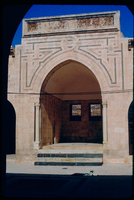| dc.description | ArchNet:
Yasser Tabbaa states in his seminal book "Constructions of Piety": "The mashhad al-Husayn is the most important medieval Shi'i structure in all of Syria. It is also the largest, most complex, and most enigmatic religious monument in Ayyubid Aleppo, comparable in all these respects to the madrasa al-Firdaws."
This assertion reveals some validity when the building is considered in architectural historical context. Mashhad al-Husayn is one Aleppo's few remaining twelfth century Shiite monuments. Along with the nearby Mashhad al-Dikkah, Mashhad al-Husayn embodies the great Shiite traditions that thrived in Aleppo before the rise of the Sunni orthodox dynasties under the Ayyubid leader Nur al-Din.
Mashhad al-Husayn was originally founded to commemorate the martyrdom of Husayn the son of Ali who was killed by the early Umayyads and also to mark the retuning strength of the Shiite community in Aleppo after the death of Nur al-Din who strongly opposed Shi'ism. The mashhad was built between 1183-1260, the long construction period was due to the slow accumulation of funds from the local Shiites that required the shrine be built in stages. It survived throughout the development of the city, earthquakes and abandonment until it was almost completely destroyed in 1920 by an explosion of ammunition that was stored in the building. Using Herzfeld's documentation photographs and drawings, the mashhad was reconstructed forty years later by the local Shiite community.
The mashhad is composed of a shrine to Husayn and al-Mukhtar Mosque. The limestone building is organized around two courtyards; the first is the entrance court, elaborately decorated with a fine honeycombed frieze over the portals. This small court leads into the larger central courtyard that is framed with an iwan at its south, the main prayer hall also at he southern end, and a service core behind a domed portico to the north. The main prayer hall (al-qibliyya) was the first part to be built and the main iwan was the second. As contributions increased, architectural elements were modified and magnified to become larger and grander with more intricate stone muqarnas ornamentations on the portals and under the domes. The smooth monochrome mihrab in the prayer hall is not marble typical of Ayyubid mihrabs, but rather intricately formed by interlacing pieces of limestone.
Mashhad al-Husayn exemplifies the architectural mastery of form and ornament of twelfth century Aleppo, while politically it played an important role as it exposed the rift between the Sunni ruling class and the Shiite community who founded the monument. The Sunni leaders contributed to the expansion of the shrine and inscribed their names on its stones to claim the shrine as a united Muslim one and to mark their authority over the grand monument. Tabbaa further explains that the mashhad al-Husayn had a wider impact on the development of Aleppo's Sunni Ayyubid monuments and madrasas around maqam Ibrahim (shrine of Abraham) as a direct reaction to the threat that mashhad al-Husayn posed to Sunni authority. In this instance, an architectural structure renders both the cultural history of its material construction and the political impact of a structure on the social conditions of the city.
Sources:
Allen, Terry. 2003. "Mashhad al-Husayn". In Ayyubid Architecture. Occidental, CA: Solipsist Press. http://www.sonic.net/~tallen/palmtree/ayyarch/ch5.htm#alep.mashh [Accessed August 2, 2005]
Tabbaa, Yasser. 1997. Constructions of Power and Piety in Medieval Aleppo. The Pennsylvania State University: The Pennsylvania State University Press, 110-121.
Burns, Ross. 1992. Monuments of Syria. London: I.B. Tauris & Co Ltd., 43-44. | en_US |


